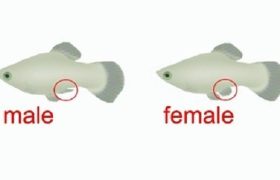Male and female fish differ in size, shape, and colouration. Knowing what to look for when identifying a male or female fish can help you make sense of the many species available in your local aquarium. While fish are not people, the way they function and the life cycle of their gender is surprisingly similar to that of humans. This article will take you through a step-by-step process to determine if your fish is male or female.
What type of fish is the most likely to be male?

If you are looking for a fish that is more likely to be male, then you should consider a cichlid. This type of fish typically has a larger head and body size compared to other fish species. Additionally, cichlids commonly have an elongated snout and a pronounced dorsal fin.
What type of fish can be female?
There are many kinds of fish that can be female, including tropical fish, cichlids, and catfish. Some types of fish that are commonly thought of as being male, like trout and salmon, can also be female. To determine whether a fish is male or female, look at its external anatomy. Female fish have larger ovaries than males do, and they often have smaller Testes.
Signs that a fish is male or female
When it comes to fish, there are a few key things that determine their gender. In general, male fish are larger and have more colorful scales than female fish. Additionally, male fish tend to have thicker tails and a wider head than female fish.
Some other signs that can help identify a fish’s gender include the shape of its genitalia (male fish typically have longer and thicker penises than females) and the size and number of its eggs. Ultimately, these clues will vary depending on the particular species of fish, but they can generally be used as a starting point in determining a fish’s sex.
Common mistakes to avoid while catching and identifying the gender of a fish
There are a few things to keep in mind when trying to determine the gender of a fish. The first is that there is no one definitive way to identify the gender of a fish, and different people may come up with different conclusions based on the same information. Additionally, some fish can change their gender over time, so it’s important to check regularly if you’re unsure.
Here are five common mistakes people make when catching and identifying the gender of a fish:
1) Not knowing what type of fish you’re dealing with. Many times, the gender of a fish can be determined by its appearance. For example, male catfish have long dorsal fins and female catfish have shorter ones. However, not all types of fish have clearly defined genders, so it’s important to be aware of what kind of fish you’re dealing with before making any assumptions.
2) Assuming that all males look alike. Just because a fish has a large male-type body doesn’t mean it’s automatically a male. Female bass might also have large bodies and big male-type fins, for example.
3) Misidentifying other species as being from the same genus or species as the fish you’re trying to sex. For example, a fan fish is not a surgeonfish and should not be identified as such. A surgeonfish is an angelfish or an angel shark of some kind, depending on the species. If you can’t find the species you’re looking for in your book, don’t assume it’s a different kind of fish simply because you’ve never heard of it before.
4) Assuming that when two males are together they will fight over females or territory. This may be true for some species but many male-female pairings are monogamous with good relationships lasting multiple years and even mating with other males on occasion.
Conclusion
If you’re looking to buy a fish, it’s important to know which ones are male and which ones are female. If you’re purchasing a fish for your aquarium or pond, it’s best to buy the appropriate sex according to the size of the fish—for instance, small males go together with small females, while large males go with large females. Larger fishes also need more space than smaller fishes do, so if you have a limited tank or pond available, make sure to buy a combination of sexes in order to accommodate as many different types of fish as possible.




